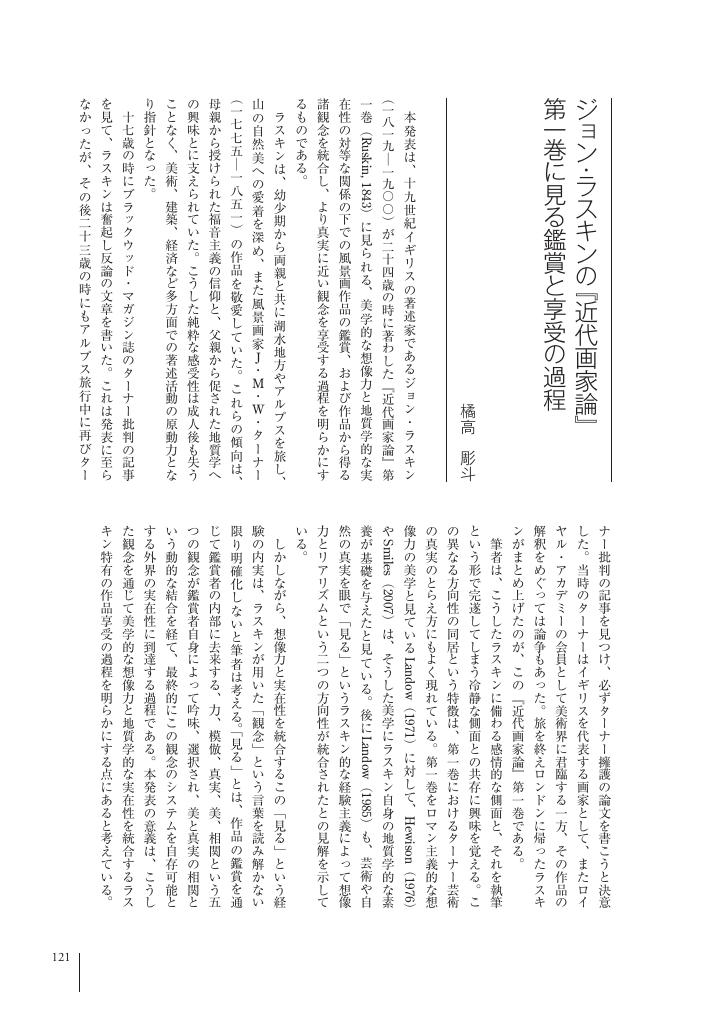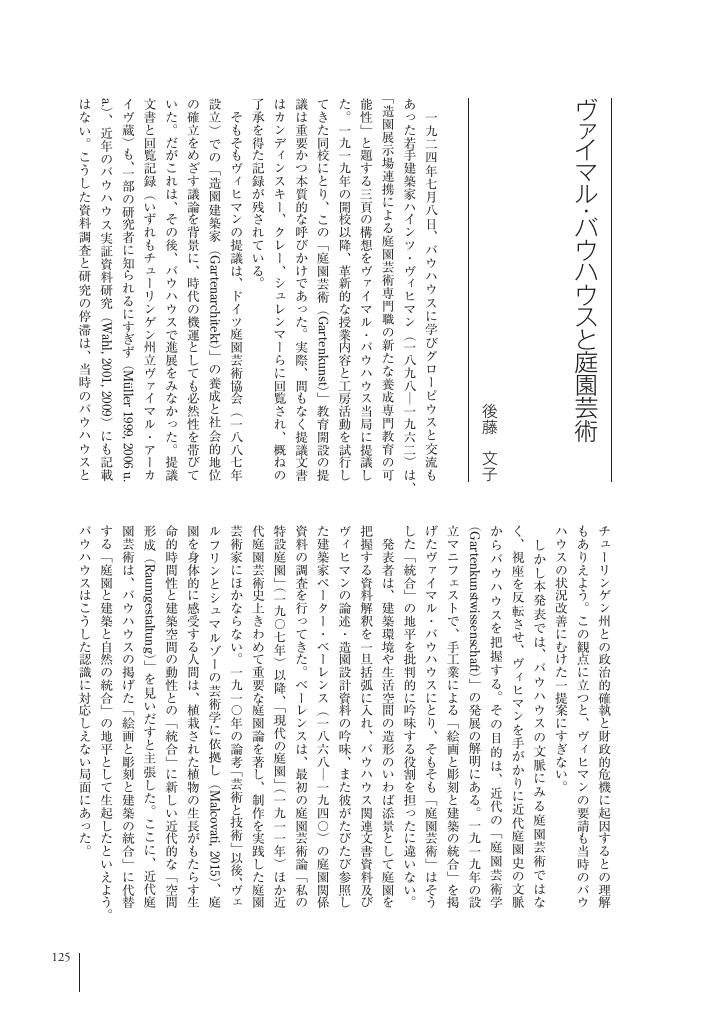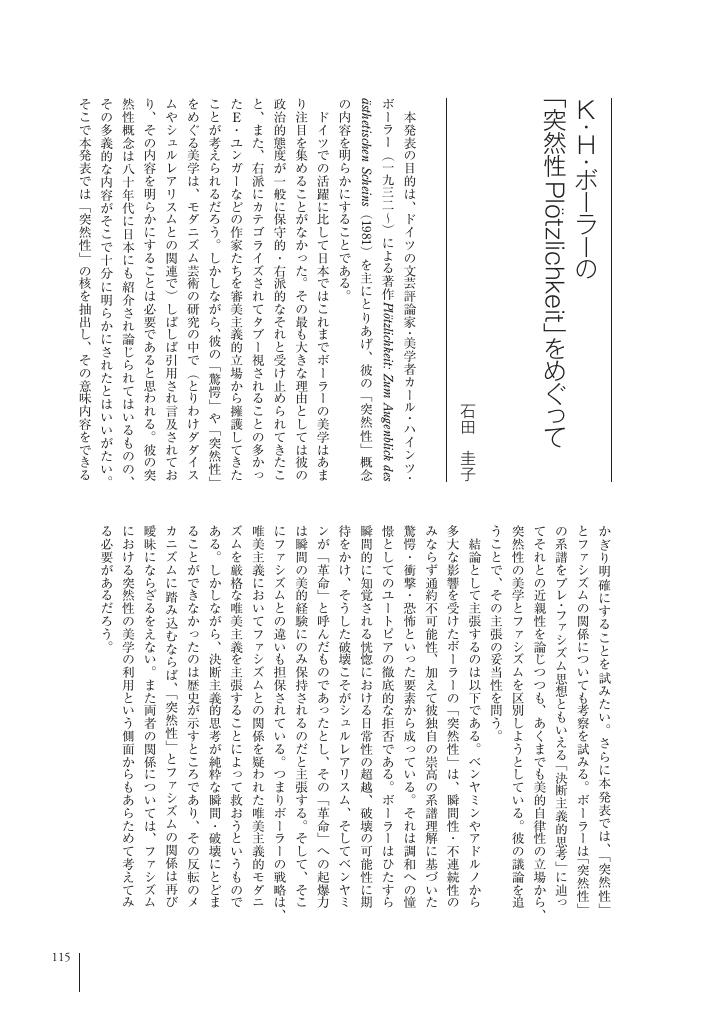- 著者
- 富岡 進一
- 出版者
- 美学会
- 雑誌
- 美学 (ISSN:05200962)
- 巻号頁・発行日
- vol.70, no.2, pp.134, 2019 (Released:2021-05-08)
1 0 0 0 OA 銭鍾書の「虚色」論 中国の伝統的詩論の発展形
- 著者
- 丁 乙
- 出版者
- 美学会
- 雑誌
- 美学 (ISSN:05200962)
- 巻号頁・発行日
- vol.70, no.2, pp.135, 2019 (Released:2021-05-08)
1 0 0 0 OA 保田與重郎の芸術論 戦後の美術批評を中心に
- 著者
- 遠藤 太良
- 出版者
- 美学会
- 雑誌
- 美学 (ISSN:05200962)
- 巻号頁・発行日
- vol.70, no.2, pp.116, 2019 (Released:2021-05-08)
- 著者
- 大城 茉里恵
- 出版者
- 美学会
- 雑誌
- 美学 (ISSN:05200962)
- 巻号頁・発行日
- vol.70, no.2, pp.117, 2019 (Released:2021-05-08)
1 0 0 0 OA ペーター・コンヴィチュニーの《ばらの騎士》演出
- 著者
- 大矢 未来
- 出版者
- 美学会
- 雑誌
- 美学 (ISSN:05200962)
- 巻号頁・発行日
- vol.70, no.2, pp.118, 2019 (Released:2021-05-08)
1 0 0 0 OA ムンクの壁画制作における 技法選択と色彩表現 同時代ノルウェーの 言説および実践との対話
- 著者
- 亀山 裕亮
- 出版者
- 美学会
- 雑誌
- 美学 (ISSN:05200962)
- 巻号頁・発行日
- vol.70, no.2, pp.120, 2019 (Released:2021-05-08)
1 0 0 0 OA ジョン・ラスキンの『近代画家論』第一巻に見る鑑賞と享受の過程
- 著者
- 橘高 彫斗
- 出版者
- 美学会
- 雑誌
- 美学 (ISSN:05200962)
- 巻号頁・発行日
- vol.70, no.2, pp.121, 2019 (Released:2021-05-08)
- 著者
- 木村 遥
- 出版者
- 美学会
- 雑誌
- 美学 (ISSN:05200962)
- 巻号頁・発行日
- vol.70, no.2, pp.122, 2019 (Released:2021-05-08)
1 0 0 0 OA 日本映画の「日本的なもの」を めぐる諸言説 一九三〇年代の批評言説を中心に
- 著者
- 具 慧原
- 出版者
- 美学会
- 雑誌
- 美学 (ISSN:05200962)
- 巻号頁・発行日
- vol.70, no.2, pp.123, 2019 (Released:2021-05-08)
1 0 0 0 OA レンブラント作 《屠られた雄牛》をめぐって 粗い仕上げが作品に付与したもの
- 著者
- 国清 景子
- 出版者
- 美学会
- 雑誌
- 美学 (ISSN:05200962)
- 巻号頁・発行日
- vol.70, no.2, pp.124, 2019 (Released:2021-05-08)
1 0 0 0 OA ヴァイマル・バウハウスと庭園芸術
- 著者
- 後藤 文子
- 出版者
- 美学会
- 雑誌
- 美学 (ISSN:05200962)
- 巻号頁・発行日
- vol.70, no.2, pp.125, 2019 (Released:2021-05-08)
1 0 0 0 OA アドルノの自然美における二つの位相 M・ゼールによるアドルノ批判の再検討
- 著者
- 府川 純一郎
- 出版者
- 美学会
- 雑誌
- 美学 (ISSN:05200962)
- 巻号頁・発行日
- vol.70, no.2, pp.25-36, 2019 (Released:2021-05-08)
In der Ästhetischen Theorie definiert Theodor W. Adorno das Naturschöne als die Erfahrung von „der Sprache der Natur“, die weder eine begriffliche, noch eindeutig zu bestimmende Bedeutung hat. Martin Seel lehnt aber diese Sprache als einen „metaphysischen“ Begriff ab, und urteilt, dass die Naturästhetik Adornos im Grunde auf einer romantischen Betrachtungsweise aufbaut. Auf Grundlage der späteren Diskussionen über die Richtigkeit dieser Kritik (Josef Früchtl, Gerhard Schweppenhäuser, Gernot Böhme) untersucht dieser Aufsatz im Folgenden den zentralen Streitpunkt, ob diese Sprache der Natur buchstäblich aus der Natur selbst kommt oder bloß durch eine Vermittlungswirkung des Subjekts konstruiert ist. Diese Lektüre führt infolgedessen zu der Interpretation, dass in der Sprache der Natur zwei Phasen ineinander verwoben sind: die Projektionsweise, in welcher der Mensch, der im mythischen Zustand quälend gefangen ist, sein utopisches Interesse auf die Natur richtet. Und die metaphysische Phase, die in der Wahrnehmung des utopischen Interesses der Natur besteht, die im Grunde ebenfalls im grausamen mythischen Zustand gefangen ist. Diese Phase beweist zwar eine gewisse Richtigkeit der Kritik Seels, aber die Lektüre macht auch ein ästhetisches Potenzial Adornos aufmerksam.
1 0 0 0 OA オズワルド・ヂ・アンドラーヂの批評におけるブラジル性について
- 著者
- 居村 匠
- 出版者
- 美学会
- 雑誌
- 美学 (ISSN:05200962)
- 巻号頁・発行日
- vol.70, no.2, pp.61-72, 2019 (Released:2021-05-08)
This paper characterizes a Brazilian critic Oswald de Andrade’s ‘Brazilianness (brasilidade)’ by analyzing his art critique. It is accepted that ‘philosophy of anthropophagy’ proposed by Andrade’s “Anthropophagy Manifest (Manifesto Antropófago, 1928)” defines the 20th century Brazilian culture. The idea of the philosophy of anthropophagy as a cultural constructional model ignores, however, socio-political visions in Andrade’s works. I clarify the significance of art for Andrade and connect his writings of art in the modernist era and socio-political writings in his later years. Andrade praises art based on Brazilian life, nature, and history as representative art of Brazil, national art. Further, according to his review concerning Anita Malfatti’s solo exhibition in 1917, Andrade criticizes art from a western point of view. Finally, the paper clarifies representations of Brazilianness by analyzing Andrade’s critiques about two painters, Tarsila do Amaral and Lasar Segall. In conclusion, I show that Brazilianness for Andrade is an expression both based on Brazilian life, nature, and history and executed well in western criteria. Andrade’s Brazilianness is also problematic in terms of internalizing of western exoticism. At the same time, however, it is possible for the Brazilianness to subvert Eurocentrism.
1 0 0 0 OA カリフォルニア時代のマン・レイ ─クヌド・メリルの「フラックス」との比較を通して
- 著者
- 木水 千里
- 出版者
- 美学会
- 雑誌
- 美学 (ISSN:05200962)
- 巻号頁・発行日
- vol.70, no.2, pp.73-84, 2019 (Released:2021-05-08)
Man Ray, American artist, went to France in 1921 asking for a place of new activity. At the outbreak of the Second World War, he returned to his country in 1940, and spent about 10 years in Los Angeles. However, while attention has focused on the photographic works of the surrealist period of the 1920s and 1930s, his activities during his stay in California is rarely discussed. One considers Man Ray led a retired life there. In this paper, focusing on the fact that Man Ray was involved in an abstract art group called “Open Circle”, we examine about his California era. In particular, our purpose is to report on his activities in the Californian art field through his relationship with the painter Knud Merrild born in Denmark, who produced the paintings and named them “Flux” with techniques such as Dripping and Pouring. Attempts to elucidate artistic activities of Man Ray in Los Angeles allow us to move away from the post war art history which explains the center of art was transferred from France to the United States, namely New York. It will also be an opportunity to review the history of art from a local perspective.
1 0 0 0 OA ヌーヴォー・レアリスムの詩学
- 著者
- 渡辺 洋平
- 出版者
- 美学会
- 雑誌
- 美学 (ISSN:05200962)
- 巻号頁・発行日
- vol.70, no.2, pp.85-96, 2019 (Released:2021-05-08)
Under the direction of the critic Pierre Restany, Nouveau Réalisme was formed at the flat of Yves Klein in Paris, on October 27, 1960. This movement was made up of 13 artists including Klein, and many of them eventually became world-famous artists. However, despite of this interesting fact, their activities as a group have not been discussed sufficiently in the past. But now, there is no doubt that Nouveau Réalisme is being historically re-evaluated all over the world. In this article, following this trend, we attempt to reexamine the movement by considering their “poetics”. Nouveau Réalisme was supported by Restany’s theory of “appropriation of the real”. But this theory was neither accepted by all participants, nor so effective to analyze their works. So, we reconsider the theory of Restany, and try to separate works of Nouveau Réalisme from the concept of appropriation. Our aim is to clarify their thoughts presented in their works themselves, and to illuminate them as poetics of Nouveau Réalisme. Our proposition is below: their particularity should be sought in “making a new sight” or “new perceptual approach to reality”, and it is here that their poetics are found.
1 0 0 0 OA 一九六〇年代初頭の高橋悠治によるジョン・ケージの「偶然性」批判
- 著者
- 峠岡 悠希
- 出版者
- 美学会
- 雑誌
- 美学 (ISSN:05200962)
- 巻号頁・発行日
- vol.70, no.2, pp.97-108, 2019 (Released:2021-05-08)
In the early 1960s, the arrival of John Cage’s aleatoric music caused a sensation in the musical world of Japan. The reaction was known as the “John Cage Shock”. Many Japanese critics and musicians considered the essence of Cage’s music to exist in the chance operations of his method of composing music. The interpretation of this concept among many critics tended to the metaphysical and mystic. Yuji Takahashi (1938-) argued that these assessments were inaccurate and asked, “Where is chance in John Cage’s works?” He proposed to understand Cage’s work through the concept of indeterminacy. Cage himself, of course, also used this term. However, Takahashi’s idea of indeterminacy differs from Cage’s; Takahashi’s idea focuses on the indeterminacy that intervenes not only between scores and performances but also between the performed sound (Takahashi referred to it as the vague sound) and the audience. However, this understanding of indeterminacy fails to account for Cage’s usage of this type of sound in his works. Cage’s aleatoric music and indeterminacy cast a long shadow over Japanese music post the Second World War. This paper assesses the reception of Cage’s music in Japan, indicating Cage’s influence on Takahashi’s compositions.
1 0 0 0 OA 居住環境における「親しみ」の美的経験の成立条件
- 著者
- 青田 麻未
- 出版者
- 美学会
- 雑誌
- 美学 (ISSN:05200962)
- 巻号頁・発行日
- vol.70, no.2, pp.114, 2019 (Released:2021-05-08)
1 0 0 0 OA K・H・ボーラーの 「突然性 Plötzlichkeit 」をめぐって
- 著者
- 石田 圭子
- 出版者
- 美学会
- 雑誌
- 美学 (ISSN:05200962)
- 巻号頁・発行日
- vol.70, no.2, pp.115, 2019 (Released:2021-05-08)
1 0 0 0 OA 香港新浪潮における作家と脚本の関係 『蝶變』を中心に
- 著者
- 雑賀 広海
- 出版者
- 美学会
- 雑誌
- 美学 (ISSN:05200962)
- 巻号頁・発行日
- vol.70, no.1, pp.130, 2019 (Released:2021-05-08)
1 0 0 0 OA ポール・セザンヌと写真 一九世紀における絵画と写真の交流の一様相
- 著者
- 秋丸 知貴
- 出版者
- 美学会
- 雑誌
- 美学 (ISSN:05200962)
- 巻号頁・発行日
- vol.70, no.1, pp.131, 2019 (Released:2021-05-08)














